So here's the Governor's announcement and explanation. I could have lived reasonably comfortably with Bill Walker getting another four years. I voted for him last time and he's an honorable man, intelligent, and appears always to have the best for Alaska in mind. I don't agree with all his positions, but that's true about most elected officials. As of today, it's (sort of) a two way race between Mark Begich and Mike Dunleavy. Walker's name will still be on the ballot and I'm sure some people will vote for him (please don't unless you were planning to vote for Dunleavy.) And the Division of Elections has said 1000 absentee votes are already in, and surely some of those folks voted for Walker.
I'll try to get something up about the trial later tonight or tomorrow. Meanwhile, here's the email the Governor sent out.
Dear Alaskans,
I ran for re-election because I still believe that, more than anything else, Alaska deserves integrity, honesty, and courage.
Alaska First is, and cannot only be, a campaign slogan. When I said I ran for governor to do the job, not make the decisions to keep the job, I meant exactly what I said. Every decision I have made as your governor, I have made on the basis of what I believe is best for Alaska.
With that said, effective today, I am suspending my campaign for re-election as Governor. With more time, I am confident that Val and I could deliver a message and a campaign that could earn a victory in this election.
But there are only 18 days remaining before election day. Absentee ballots have already been mailed, and Alaskans are already voting. In the time remaining, I believe we cannot win a three-way race.
This week I have talked to many Alaskans to determine whether I or Mark Begich had a better chance of running a competitive race against Mike Dunleavy. The determination was made that, at this point, Begich has the better odds.
Alaskans deserve a competitive race. Alaskans deserve a choice other than Mike Dunleavy, whose record and campaign rhetoric indicate he will:Moreover, my administration has worked tirelessly to improve the relationship between Tribes and State and restore respect for Alaska's First Peoples in state government. Yesterday, I apologized on behalf of the State of Alaska for the wrongs committed against the Alaska Native people throughout our history, because I believed that was best for Alaska. My expectation is that this work critical to the healing of historical trauma and unifying all Alaskans will be undone in a Dunleavy administration.
- eliminate Medicaid Expansion that has provided healthcare access to 44,000 Alaskans, created jobs and brought $1 billion federal dollars into the Alaskan economy while decreasing State healthcare expenditures by $16 million, kept hospitals from closing, and saved lives;
- defund the Alaska LNG Gasline project that has made historic progress, will create 12,000 high paying construction jobs, 88,000 direct and indirect jobs and deliver low cost energy to our homes and businesses;
- undo the bipartisan approved sustainable fiscal plan that has resulted in fiscal stability, significantly reduced the deficit, improved our credit rating and preserved the PFD program into perpetuity;
- cause our most vulnerable to suffer the brunt of the additional $1 billion in budget cuts he vows to make to education, rural Alaska and those receiving healthcare.
On balance, it is my belief that despite my many differences with Mark Begich, his stance on the important issues I have listed above more closely align with my priorities for Alaska.
This is not the first difficult decision I have made this week, but it is one I know I must make. There simply are no words to express my deepest gratitude to the incomparable, dedicated team of outstanding Alaskans who have served in my administration and to the thousands of supporters, donors, volunteers and campaign staff who have been passionately committed to my re-election. And above all, I want to say thank you to my family and to Donna, my first lady for life.
As I said earlier this week, ultimately, it's not how long my team and I serve, it's how well we served the people and the state we love while the opportunity was ours. We have served with integrity, courage, devotion, and compassion, never asking ourselves whether a decision is politically correct but always asking if it is right for Alaska. I am proud of the work we have done in the most challenging fiscal crisis in state history and it is the honor of my life to have served as the governor of this great state.
Thank you, God bless you all, and may God continue to bless Alaska.
Bill Walker
In this age of cynicism about politics, I thank Governor Walker for what he's done in the last four years and for taking this difficult step.


























